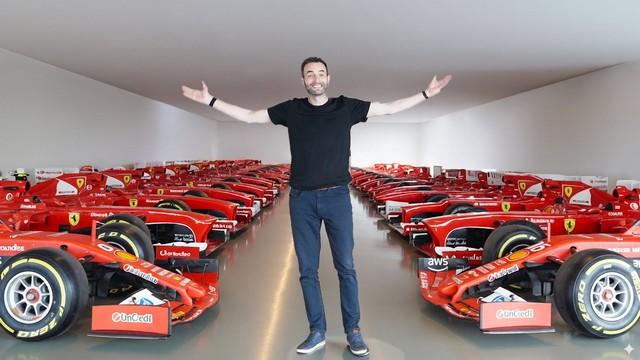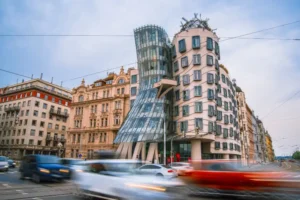There are few places in motorsport that command the same aura of reverence as Maranello, Ferrari’s hallowed hometown. Every street, every workshop, every echo of an engine seems infused with the mythology of the Scuderia. Yet even within this sacred geography, certain spaces remain off-limits—vaulted rooms where the weight of history rests on carbon fiber and steel.
It is into one such space that Scott Mansell, former Formula 1 driver and respected motorsport analyst, has taken viewers. His journey into Ferrari’s secret Formula 1 bunker unveils more than just cars; it uncovers the evolution of racing itself, told through over 80 historic machines spanning five decades. From the raw, visceral monsters of the 1970s to the hyper-engineered marvels of the modern age, the collection is both a shrine and a laboratory of progress.
The Man Behind the Tour: Scott Mansell
Scott Mansell is no ordinary guide. A driver who once carved his way through the motorsport ladder, Mansell has since become one of the sport’s most articulate voices. His ability to demystify complex engineering while retaining the emotional gravity of racing has made his Driver61 platform and YouTube series essential viewing for fans.
Mansell’s tour of the Ferrari bunker is more than a technical walk-through; it’s an emotional pilgrimage. Every car he encounters isn’t just a chassis with a serial number—it’s a story, a season, a battle fought on tracks from Monaco to Suzuka. His expertise allows viewers to appreciate not only the aesthetic beauty of the machines but also the subtle aerodynamic innovations, the material science breakthroughs, and the cultural moments each car embodies.
The Bunker: Ferrari’s Hidden Cathedral of Speed
The term “bunker” may conjure images of secrecy, and in Ferrari’s case, the description is apt. Nestled within Maranello’s compound, this climate-controlled vault is part museum, part archive, part workshop. Few outsiders have ever been allowed to enter, let alone film.
Walking through the rows, one is immediately struck by the red continuum: Ferrari’s racing livery shifting subtly through eras, from the deeper crimson of the 1970s to the brighter scarlet of the 1990s, and finally, the glossy finishes of today’s hybrid age. Each car is positioned like a chapter in a book—progressively narrating how Formula 1 transformed over the years.
The 1970s: Raw Power and Unrefined Danger
Mansell begins with Ferrari’s machines from the 1970s, a period of visceral danger and mechanical boldness. These cars, stripped of modern electronic aids, were monsters tamed only by human courage.
Their designs prioritized brute horsepower, with massive airboxes looming above drivers’ heads and wings that seemed more like afterthoughts than carefully calculated elements of aerodynamics. Safety was rudimentary; cockpits were cramped, survival cells nearly non-existent.
And yet, these cars defined legends. Niki Lauda’s 312T series—one of which resides in this bunker—represents the blend of precision engineering and fearless driving that delivered Ferrari back to championship glory in 1975 and 1977. For Mansell, to stand before these machines is to confront the essence of Formula 1 as gladiatorial combat.
The 1980s: Turbocharged Warfare
Moving deeper into the collection, Mansell encounters the turbocharged beasts of the 1980s. These cars, such as the Ferrari 126C2, marked the era when turbo engines redefined performance. With qualifying trims producing upwards of 1,200 horsepower, drivers were effectively wrestling rockets strapped to four wheels.
Aerodynamics became sharper, ground effect experiments pushed boundaries, and cars began to look more like missiles than machines. Mansell notes the brutal transition between throttle inputs and turbo lag, making these Ferraris among the most unpredictable yet thrilling cars to drive.
The bunker contains examples of both triumph and tragedy, embodying the decade’s extremes: heroic wins and harrowing losses, technological leaps and ethical debates about safety.
The 1990s: The Schumacher Prelude
By the 1990s, Ferrari was reestablishing its dominance, though championships still eluded them until the dawn of the new millennium. Cars such as the F310 and F399 stand in the bunker as transitional figures—sleeker, more aerodynamic, and laden with the electronic aids that defined the era.
Mansell points out how Ferrari’s design language matured during this period, aligning with the arrival of Michael Schumacher and technical mastermind Ross Brawn in 1996. These cars laid the foundation for the juggernaut Ferrari would soon become.
The 2000s: The Schumacher Dynasty and the F2004
If the earlier sections of the bunker evoke admiration, then the row of early-2000s Ferraris inspires awe. Here stands the evidence of Ferrari’s most dominant era, when Schumacher and the Scuderia won five consecutive drivers’ championships (2000–2004) and six constructors’ titles.
At the heart of this dynasty is the F2004, the crown jewel of Ferrari’s collection. Mansell lingers over this machine, his voice tinged with reverence.
The F2004 wasn’t merely successful—it was untouchable. Over the course of the 2004 season, Schumacher and teammate Rubens Barrichello delivered 15 wins out of 18 races, with Schumacher securing his seventh and final world championship. The car set lap records so enduring that some stood for over a decade, even against hybrid-era machinery.
Key innovations included:
A 3.0-liter V10 engine producing over 900 horsepower.
A refined seven-speed semi-automatic gearbox allowing blisteringly quick shifts.
Aerodynamic refinements that balanced downforce and top-end speed with uncanny precision.
Reliability so bulletproof it seemed to mock the fragility of rival teams.
Mansell highlights the car’s uncanny ability to generate stability through corners, allowing Schumacher to drive closer to the limit than anyone else on the grid. For many, the F2004 is not just a Ferrari masterpiece—it is the apex of Formula 1 design before the rulebook clipped the wings of innovation.
The Modern Era: Hybrid Complexity
The bunker’s final rows bring us into the present. Sleek, complex machines adorned with intricate aerodynamic surfaces and halo devices embody a sport now as much about software as hardware. The Ferrari SF70H and later hybrids demonstrate the challenge of balancing raw speed with sustainability.
Mansell notes how the DNA of Ferrari persists even through regulation changes. The cars remain unmistakably Ferrari—scarlet bodies carrying both the weight of history and the burden of expectation.
Why the Bunker Matters
This hidden archive is more than a collection—it is a time capsule of Ferrari’s identity. It reminds us that Formula 1 is not just about winning races; it is about pushing the boundaries of what is possible in engineering, design, and human endurance.
For Ferrari, whose brand is inseparable from its racing legacy, the bunker symbolizes continuity. Every car here is a building block, each design informing the next, every innovation cascading forward.
Scott Mansell’s Perspective
What makes this tour extraordinary is Mansell’s ability to contextualize each car. He speaks not only about horsepower and lap times but about what it meant to drive them—the terror of 1970s cockpits, the whiplash of turbo lag in the 1980s, the supreme confidence of piloting a car like the F2004.
He translates engineering into emotion, allowing fans to feel the difference between eras and understand why the F2004 remains unrivaled in the collective imagination.
Flow
Why does the F2004 resonate so deeply? Partly because of Schumacher’s brilliance, partly because of the car’s dominance, but also because it represents a last moment of pure Formula 1 performance before regulations curtailed development.
For many fans, it is the car that defines Ferrari: fast, beautiful, and unstoppable. In the bunker, surrounded by decades of innovation, the F2004 still feels like the center of gravity—a machine so perfect it continues to shape how we think about Formula 1.Conclusion: A Vault of Dreams
Scott Mansell’s journey into Ferrari’s secret Formula 1 bunker offers more than voyeuristic thrills. It provides a structured narrative of how Ferrari—and by extension, Formula 1 itself—has evolved over fifty years. From the visceral machines of the 1970s to the hyper-engineered hybrids of today, each car carries stories of triumph, tragedy, and transformation.
At the pithy of it all is the F2004, the crown jewel that crystallizes Ferrari’s essence: innovation fused with dominance, beauty fused with brutality.
In a sport where every millisecond counts, Ferrari’s bunker reminds us of something timeless. Formula 1 is not just about speed—it is about history, identity, and the relentless pursuit of perfection. And thanks to Scott Mansell’s tour, the world has now glimpsed Maranello’s greatest treasure.
No comments yet.







